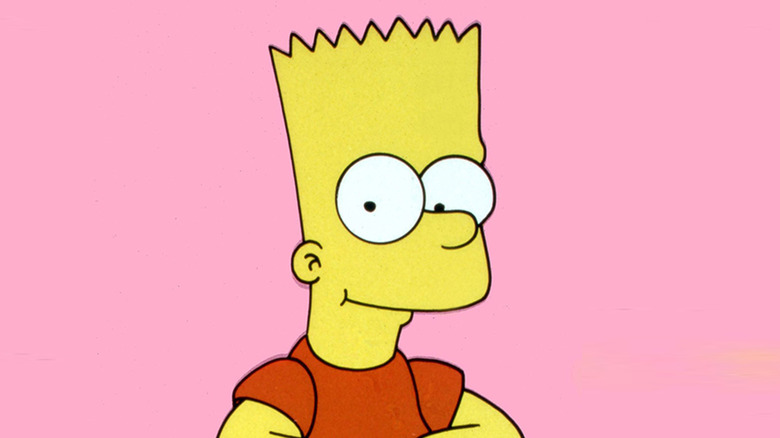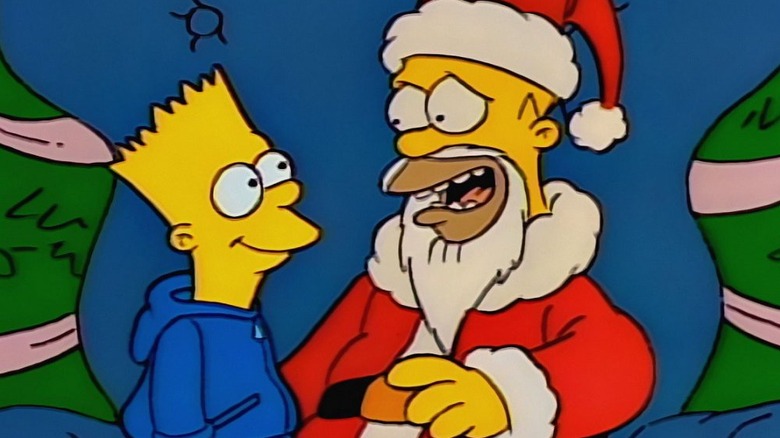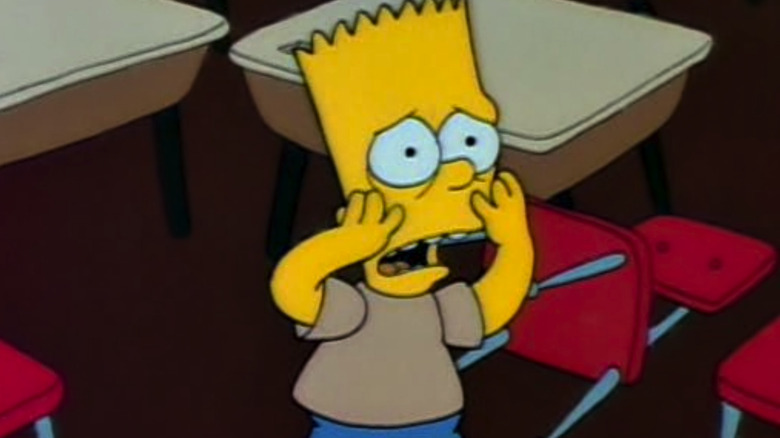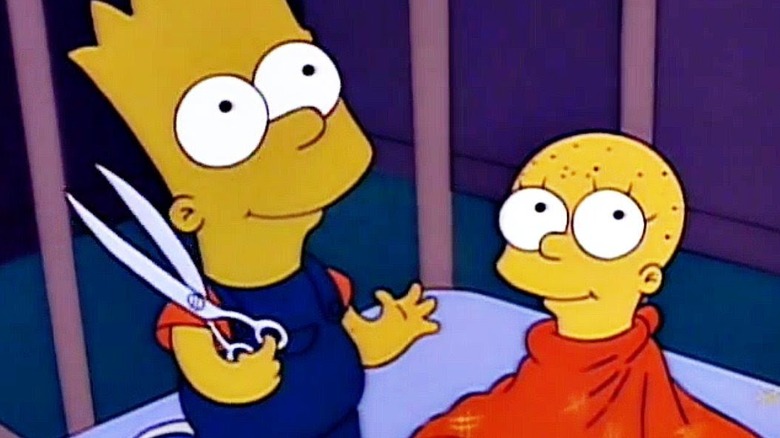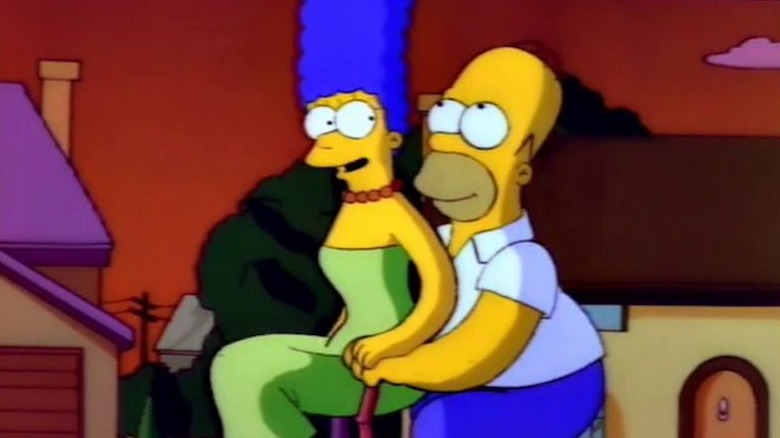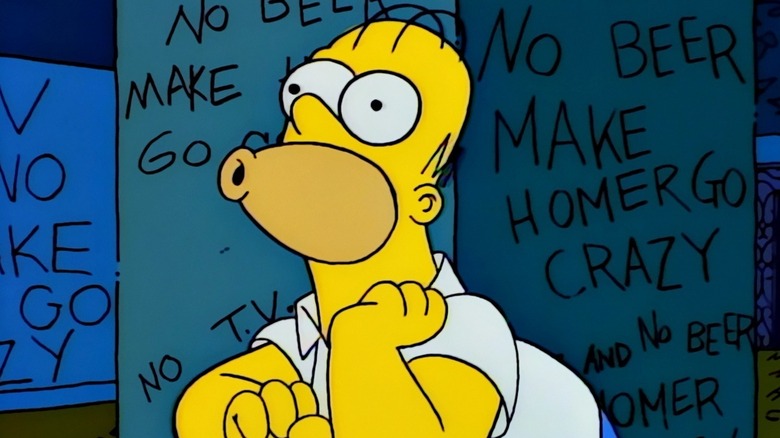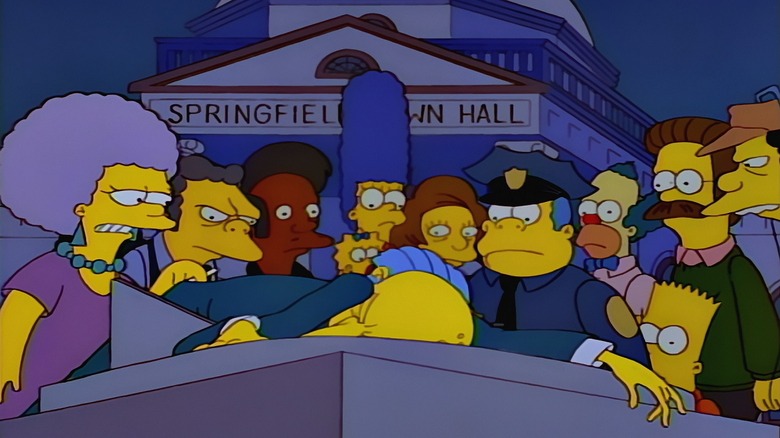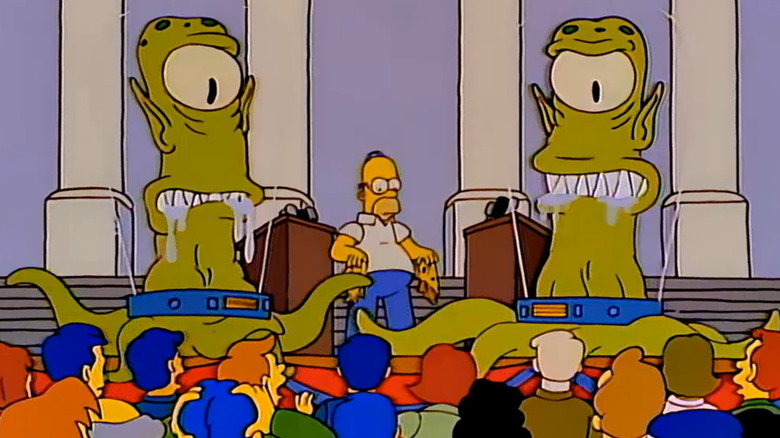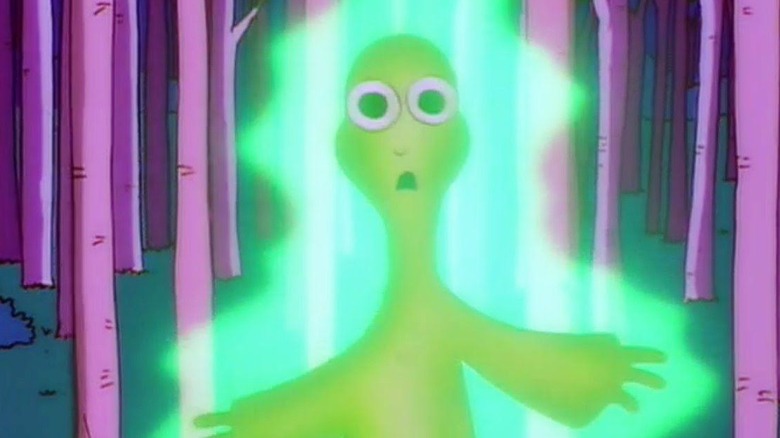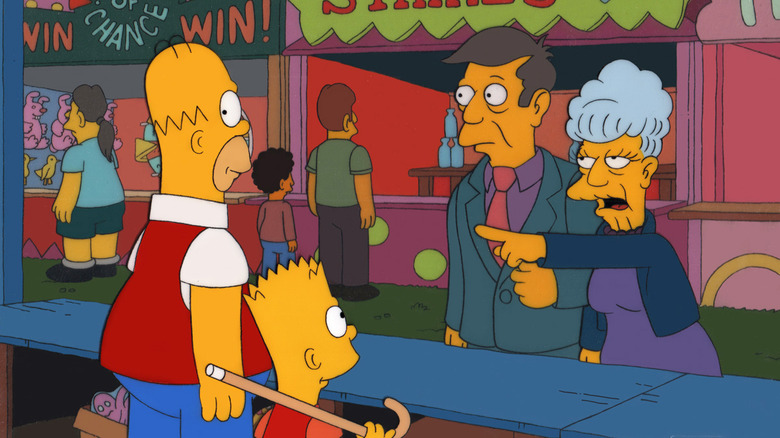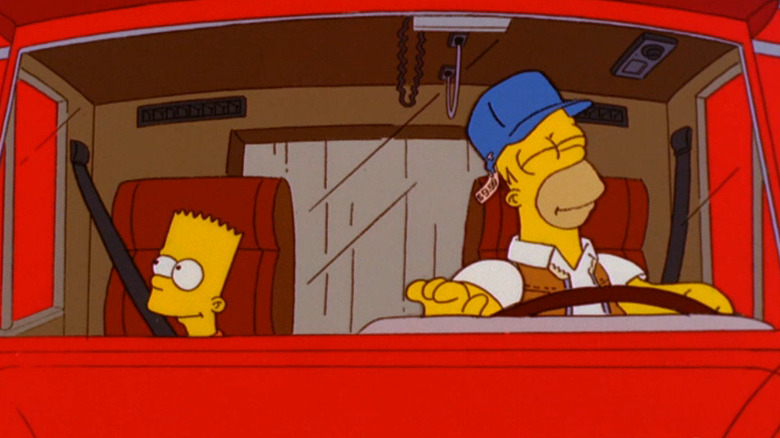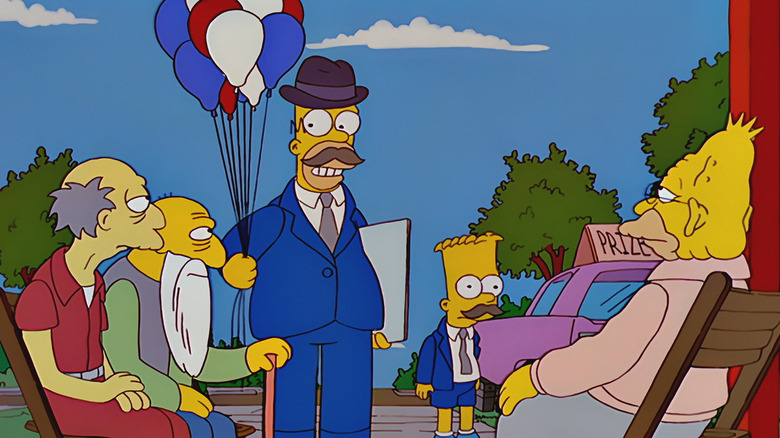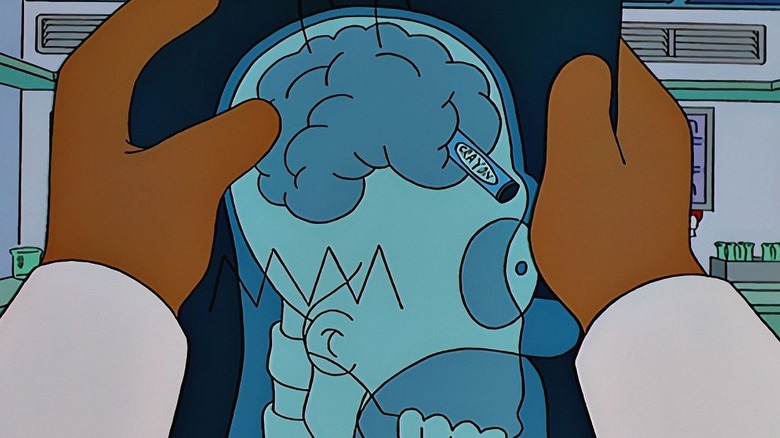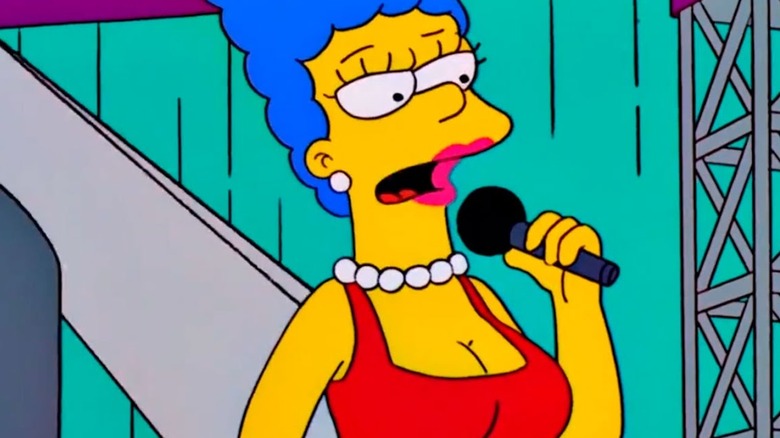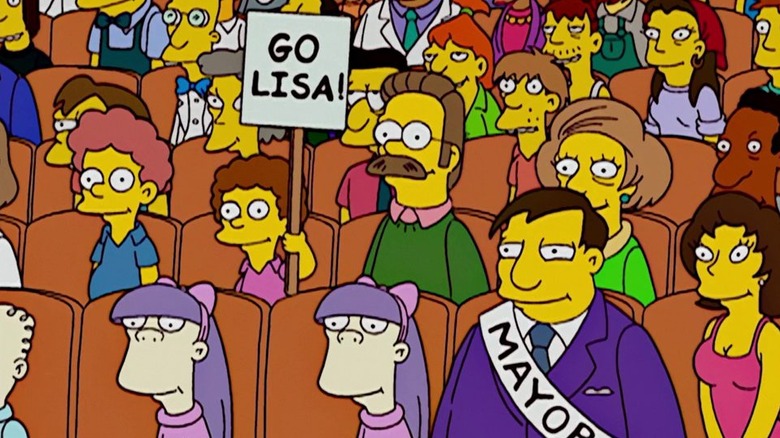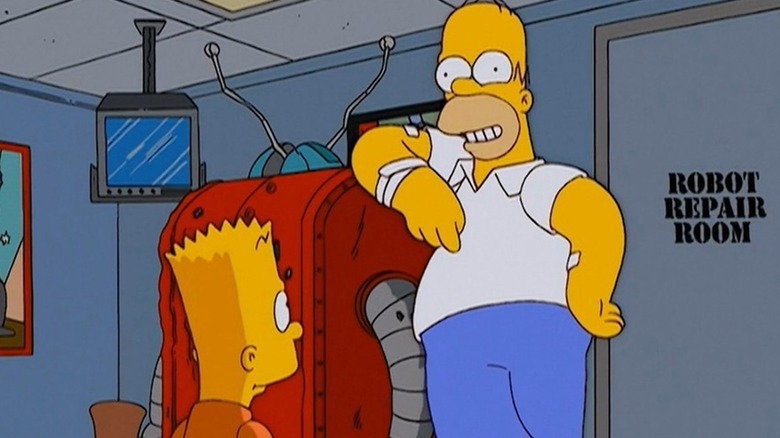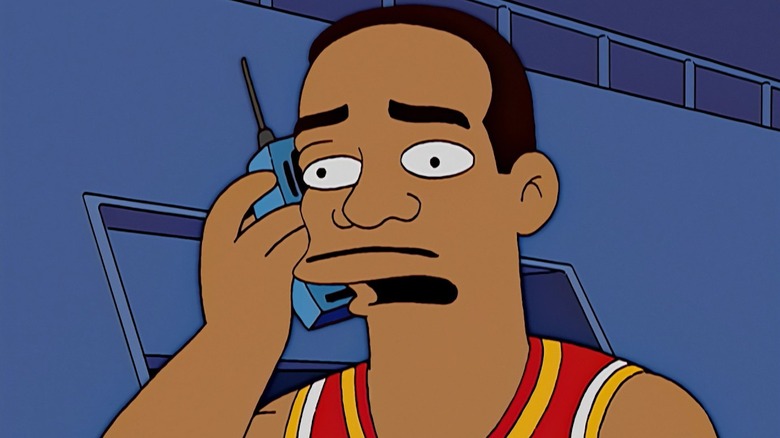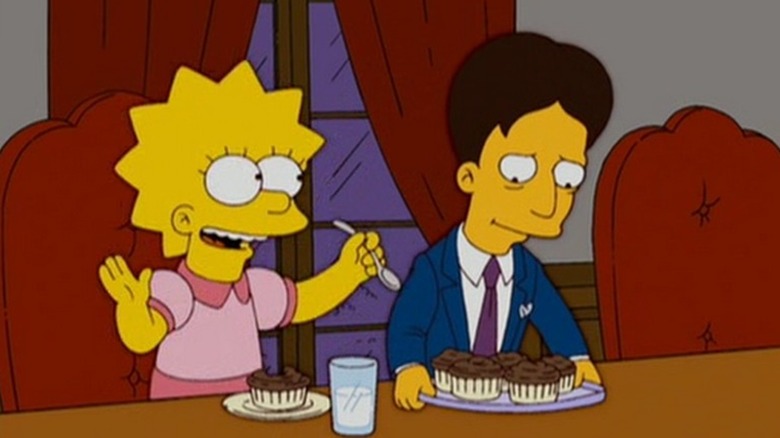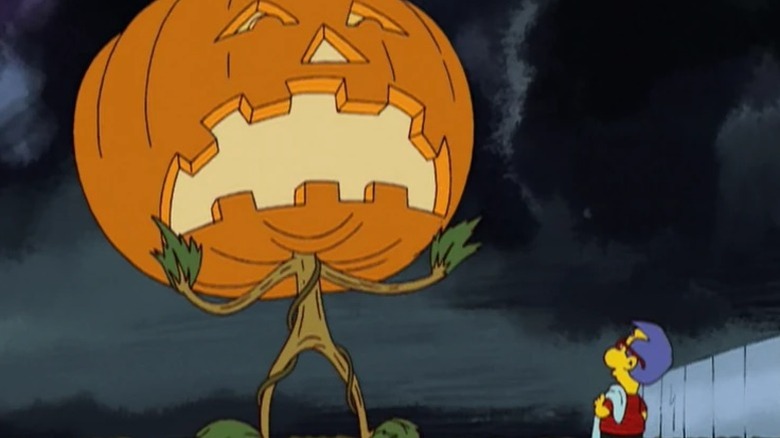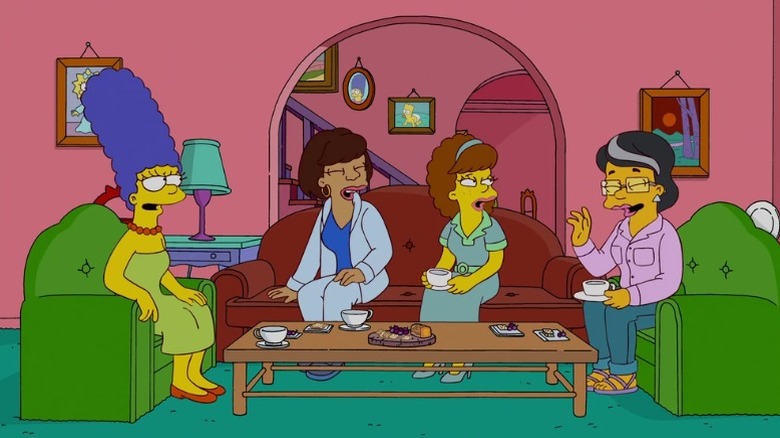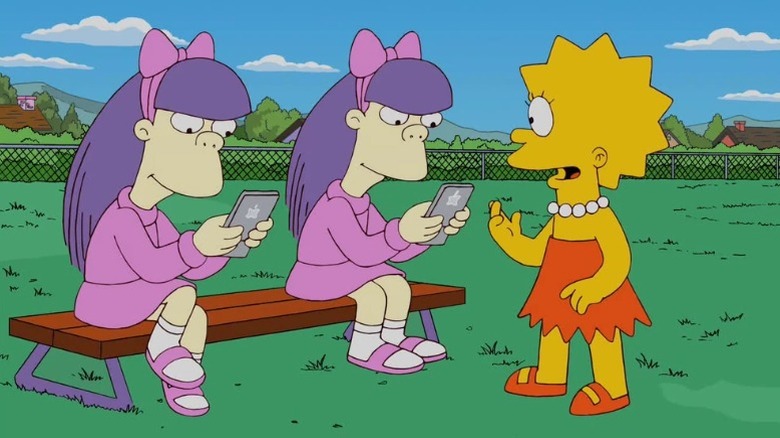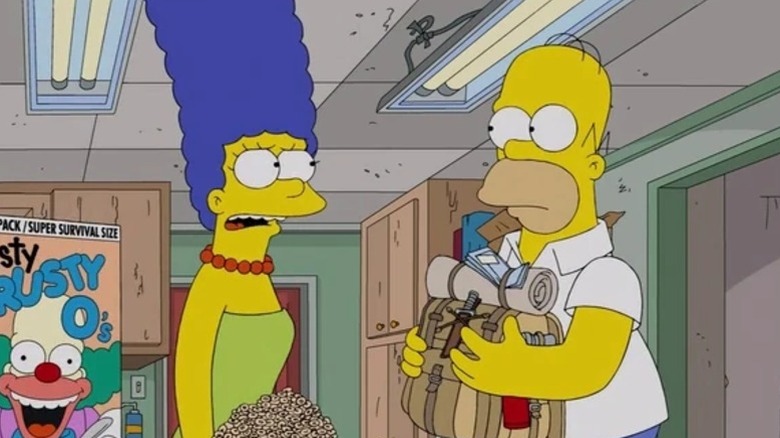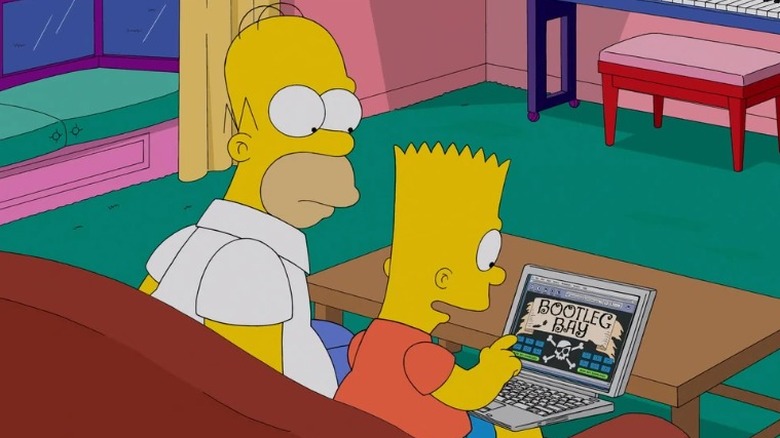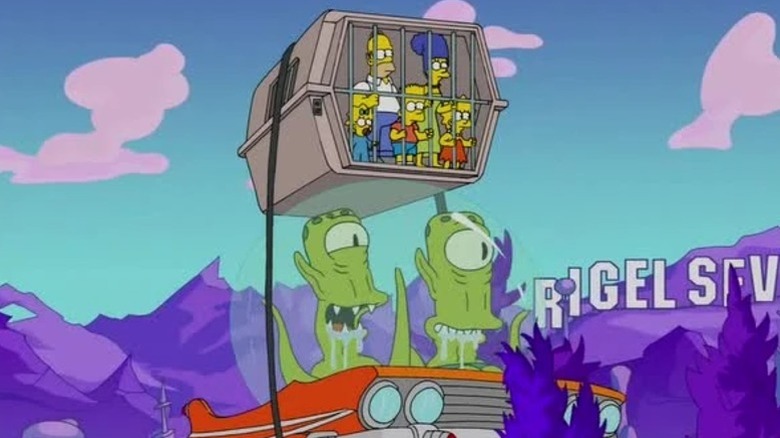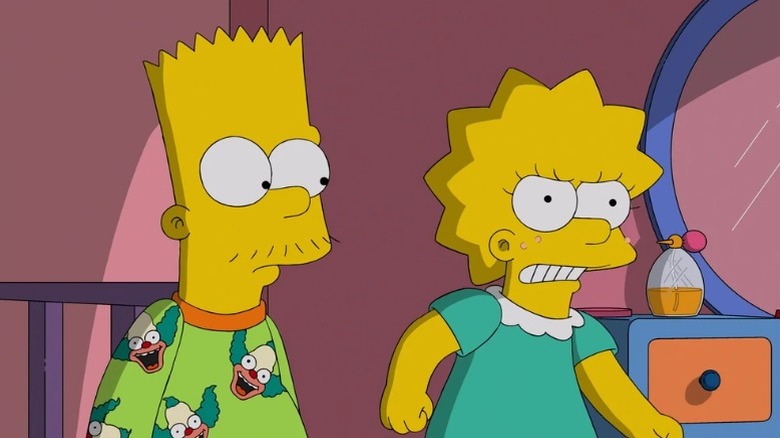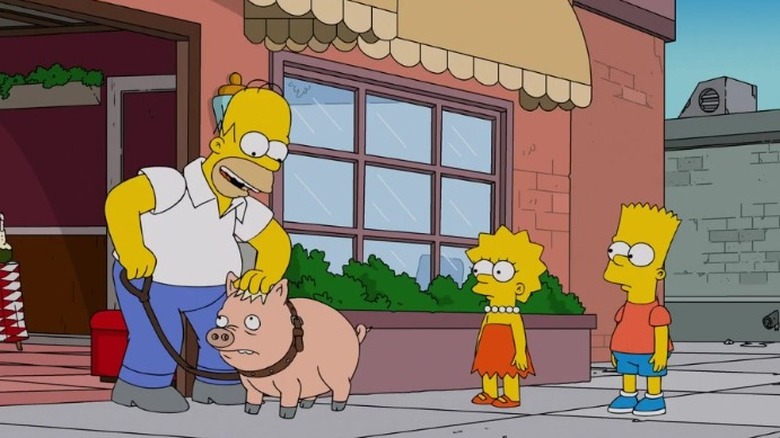The Most Popular Simpsons Episode The Year You Were Born
Not only is it among the most recognizable, acclaimed, and influential shows in history, "The Simpsons" has just flat-out been on television for a really long time. With around 790 episodes produced to date, the show has put out 36 separate seasons to date — and that doesn't even count the stack of "Simpsons" shorts that aired as interstitials on Fox's "The Tracey Ullman Show" in the late 1980s. All told, "The Simpsons" has been airing on Fox (with reruns on local stations, cable, and on Disney+) for well over three decades. Let that sink in: "The Simpsons" is almost as old as its own never-aging main character, Homer Simpson.
"The Simpsons" has been around for so long, in fact, generating a plethora of memorable jokes, bits, scenes, memes, and iconic pop culture moments, that "Simpsons" episodes can be used to mark the passage of time. Episodes are firmly rooted in the years in which they first aired, either through explicit references, or in the minds and hearts of viewers, who will never divorce certain episodes from who they were when they debuted. In honor of the show's longevity, we propose a new sort of horoscope: One based upon the most popular episode of "The Simpsons" in one's birth year. These are those ratings-grabbing installments, from 1989 to 2018.
1989: Simpsons Roasting on an Open Fire
The most popular episode of "The Simpsons" to air in 1989 was also the only episode of "The Simpsons" to air that year. The episode in question is "Simpsons Roasting on an Open Fire," also known as "The Simpsons Christmas Special," which is the very first full-length episode of the now longest-running show in primetime history. The Simpson family had been appearing in short, crudely-animated segments on Fox's "The Tracey Ullman Show" since April 1987, but "Simpsons Roasting on an Open Fire" was their first true standalone adventure.
It's a classic "Simpsons" tale, one that combines a story about Homer (Dan Castellaneta) bumbling through life in order to make his family happy with a lot of embarrassingly relatable moments, hilarious disappointments, and cutting satirical humor. A Christmas celebration is in jeopardy for the cash-strapped Simpsons when power plant owner Mr. Burns (Christopher Collins) chooses fat executive raises over holiday bonuses for employees like Homer.
Homer doesn't tell Marge (Julie Kavner), because she's got a big jar of money stashed away in her blue beehive — which she has to use on laser skin surgery after Bart (Nancy Cartwright) gets an unauthorized tattoo. Forced to take on emergency secondary employment, Homer becomes a lackluster mall Santa, and takes the paltry $13 he earns to the dog track, where he promptly loses it all. Happily, however, he wins the day by finding the perfect Christmas gift in rejected greyhound Santa's Little Helper.
1990: Bart Gets an F
In 1990, "The Simpsons" was just about the hottest thing on television. Primetime TV hadn't enjoyed a successful animated series in decades, while viewers had never seen a family sitcom as defiantly frank and cuttingly funny as "The Simpsons." This family's flaws, dysfunction, and realism propelled them to massive popularity.
Bart Simpson quickly became the breakout star: The self-proclaimed troublemaker appeared on countless T-shirts, rapped on the hit novelty song "Do the Bartman," and served as the centerpiece of the show's second-season premiere, "Bart Gets an F," the most watched "Simpsons" episode in the "Simpsons"-mad year of 1990.
Appropriately enough, this installment forces Bart to reckon with his choices and bad boy ways. After improvising his way through a book report on "Treasure Island" (which he didn't bother to read), then cheating off Milhouse (Pamela Hayden) on a test (for which he didn't study), the school psychiatrist tells Homer and Marge that it would be best for Bart to repeat the fourth grade. Dead set against that, he endeavors to improve his marks, and gets class brain Martin (Russi Taylor) to tutor him in exchange for popularity lessons. After pushing himself to study, even on a snow day, Bart triumphs in school and does well enough on a history test to pass — though he barely scores a D-minus.
1991: The Way We Was
Viewers can ascertain from clues in early episodes of "The Simpsons" that Homer and Marge Simpson are in their late 30s, and had met at Springfield High School. The 1991 flashback episode "The Way We Was" provides a lot more detail by depicting the story of Homer and Marge's first days as a couple. The idea of a '70s-set "Simpsons" episode featuring young, bellbottoms-sporting Homer and Marge was irresistible, and "The Way We Was" wound up as the series' most-watched episode of 1991.
Back in 1974, high school senior Homer lands in detention yet again for smoking in the boys' room. Studious and upstanding Marge winds up there for the first time, because she burned a bra at a feminist rally. When she walks in, it's love at first sight for Homer, and he vows to get her to love him back, and also go to the prom with him.
To get close to her, Homer hires Marge as his French tutor, despite not actually taking that class. After an undeniable chemistry develops between them — and she accepts his prom invite — he lets slip that he lied about French. Marge goes to the prom with handsy nerd Artie Ziff (Jon Lovitz) instead, standing up Homer who somehow thought she'd still attend with him. At the end of an awful night for them both, Marge picks up Homer off the side of the road, and they share their first, fate-sealing kiss.
1992: Lisa's First Word
The title implies that this 1992 episode prominently features Lisa Simpson (Yeardley Smith) as a baby, and indeed it does. But the real draw here, and probably the reason why enough people tuned in to make this the most-watched "Simpsons" episode of the year, is a milestone in the life of Maggie Simpson. In the run-up to this episode's airing, Fox heavily hyped the fact that Hollywood legend and two-time Academy Award-winner Elizabeth Taylor would guest star as Maggie.
The baby famously never speaks, and the uttering of her first words was poised to be a TV event. But "Lisa's First Word" takes its time getting to that moment. The installment is primarily a flashback episode to 1984, when Bart was a difficult toddler and a reluctant older brother to baby Lisa. We begin with the Simpsons' move into their home on Evergreen Terrace. Bart is forced to contend with a creepy clown bed, as he must give up his crib for Lisa. The new addition gets so much of his parents' attention that Bart threatens to run away, but is stopped forever when Lisa says her first word: "Bart."
At the end of the episode, the action returns to the present, where Homer puts Maggie to bed, telling her he's in no rush for her to speak, as that means she'll eventually talk back. After he closes the door and leaves, Maggie removes her omnipresent pacifier, and, with the voice of Elizabeth Taylor, says simply, "Daddy."
1993: Duffless
Homer Simpson is a man of simple, identifiable tastes: He likes to watch TV, eat junk food, snuggle with Marge, and drink as much beer as he can, either at home or at Moe's Tavern, until the alcohol shuts off his brain for the night. Thus, Homer floats through life, enjoying those things that bring him pleasure and rarely facing the consequences for his tendency to overindulge. But in "Duffless," the single most-viewed "Simpsons" episode of 1993, Homer pays the price for his love of beer.
One day, Homer sneaks out of work to take the Duff Brewery tour with Barney (Dan Castellaneta). Naturally, they both consume some beers, rendering Barney physically unable to drive. Homer, buzzed but not as drunk as Barney, agrees to drive them home, and is immediately busted by Chief Wiggum (Hank Azaria), who arrests Homer. Charged with drunk driving, he's forced to attend traffic school and Alcoholics Anonymous meetings, and is stripped of his license for a month.
Marge, worried about Homer's addictive behaviors, thinks giving up beer for a month might be a good idea for him. He reluctantly agrees, and though it's difficult, he eventually succeeds. In the process, he saves $100 and loses so much weight he no longer sweats while eating. At the conclusion of the month, he even resists his pull towards beer once more, opting to go on a bike ride with Marge rather than hang out with the sad barflies at Moe's.
1994: Treehouse of Horror V
The annual "Simpsons" Halloween specials, which consist of three unrelated, non-canonical tales of horror, science fiction, and weirdness that are often also a spoof of a well-known movie or TV show, are a TV tradition that endures today. In 1994, the phenomenon reached critical mass as that Halloween season's entry, "Treehouse of Horror V," ranked as the most viewed episode of the entire calendar year. It's no mystery as to why: Its three segments are among the funniest, most memorable, and even most frightening of all the "Treehouse of Horror" segments ever produced.
In "The Shinning," a parody of horror classic "The Shining," Mr. Burns (Harry Shearer) hires the Simpsons to be the winter caretakers of his lodge, but makes sure to get rid of all the beer and TV sets, sending Homer into a murderous rage. In "Time and Punishment," Homer tries to fix the toaster and accidentally turns it into a time-travel device. After going back too far and squishing a prehistoric creature, he zaps through various messed-up timelines, including a Ned Flanders-ruled dystopia and a world where donuts rain down from the sky.
The episode finishes out with "Nightmare Cafeteria," wherein Principal Skinner solves his overcrowded detention hall problem by helping Lunchlady Doris (Doris Grau) solve her underfunded lunchroom problem: They engage in the murder and cannibalism of Springfield Elementary students.
1995: Who Shot Mr. Burns, Part 1
Although the show is about yellow-skinned cartoon people who never age, "The Simpsons" is one of the most realistic shows on television, featuring relatable characters acting in true-to-life (well, mostly) ways. For example, millions of viewers can relate to having a boss as greedy and self-serving as Homer's, Springfield Nuclear Power Plant owner C. Montgomery Burns. The 1995 episode "Who Shot Mr. Burns, Part 1" demonstrates just how truly evil the frail and wicked energy tycoon can get.
After oil is discovered under Springfield Elementary School, bringing much-needed funds to the poorly-resourced institution, Burns steals the lucrative crude with "slant drilling." Not only does he destroy large parts of Springfield in the process, including Moe's Tavern and the Springfield Retirement Castle, he locks up a monopoly on energy, forcing the whole town to get their power from Burns' sources. He further ensures his dominance by eliminating all natural light, building a huge disc to block out the sun.
By the end of the episode — a season-ending cliffhanger, which is the first half of a two-part episode — Mr. Burns has been shot, and is barely clinging to life while sprawled out on a sundial. He did make a lot of enemies in this odd, vengeful town, after all, so it was only a matter of time.
1996: Treehouse of Horror VII
Two years after scoring some of its biggest Halloween ratings ever, another "Simpsons" fright-fest, "Treehouse of Horror VII," pulled in enough viewers to rank as the top episode of 1996. Interest may have been juiced somewhat by the fact that this was a presidential election year in the United States, with attention turned to the race between incumbent Bill Clinton and Republican challenger Bob Dole. The always satirical "Simpsons" made fun of both candidates in this Halloween episode by having recurring alien invaders Kang (Harry Shearer) and Kodos (Dan Castellaneta) kidnap the two men, take over their bodies, and run in their stead.
As they point out, after Homer exposes them, the United States has a two-party system, so Americans have to vote for one of them — and then wind up enslaved. In the anthology episode's other two segments, Lisa's tooth-in-a-Petri-dish experiment leads to a tiny, rapidly evolving society, and the family meets Hugo, Bart's monstrous, presumably evil, fish-head-devouring, formerly conjoined twin brother, who's been kept chained up in the Simpson family attic.
1997: The Springfield Files
Fox was responsible for more than a few hits that dominated pop culture in the 1990s, among them "Melrose Place" and "Beverly Hills, 90210." But only one super-hot drama dared crossover with "The Simpsons": "The X-Files," the creepy show about FBI agents Fox Mulder (David Duchovny) and Dana Scully (Gillian Anderson). Bringing those two characters (voiced by their original actors) to "The Simpsons" was, at its core, a ratings-boosting publicity stunt, and it worked like gangbusters: "The Springfield Files" was the most-watched episode of the animated series for the entirety of 1997.
One night, a very drunk, breathalyzer-failing Homer walks home from Moe's Tavern and stumbles into the woods, where he comes face to face with something utterly unexplainable: A wispy, glowing, big-eyed creature resembling popular depictions of aliens. The entity wishes no harm to Homer, but that doesn't make it any less terrifying. News of the encounter reaches Mulder and Scully, and they journey to Springfield to solve the case.
Once again, the creature appears in the woods, and once more horrifyingly proclaims peace. Bart catches footage of the event on video. Eventually, it's not the "X-Files" duo that cracks the case, but Lisa. She makes Mr. Smithers (Harry Shearer) come forward to explain that the presumed alien is actually the elderly, decrepit Mr. Burns, whose weekly life-preserving medical treatments leave him confused and disoriented. The glow comes from working around nuclear power for as long as he has.
1998: Bart Carny
Over the course of hundreds of episodes, "The Simpsons" has cracked jokes at the expense of nearly everyone and everything that factors into American life, no matter how big or how small. In "Bart Carny," the best-performing "Simpsons" episode of 1998, the show goes after a familiar slice of sketchy Americana: Traveling carnivals and the people who run them.
The carnival comes to Springfield, much to the delight of Homer Simpson and his kids. Bart gets himself embroiled in trouble pretty quickly when he hijacks the carnival's proudly displayed limousine, which once belonged to Hitler, and smashes it into a tree. To pay for the damages, Bart and Homer become carnival workers, or "carnies" as they're often called.
Under the tutelage of father-son carnie duo Cooder and Spud, the Simpson guys learn all about fixed games and police bribes, although Homer fails to properly pay off Chief Wiggum. That gets the game Cooder and Spud work (and also live in) shut down. Taking pity on them, Homer invites them to stay with his family. He shouldn't have trusted these two carnival folkies — they temporarily steal the house and assume ownership after sending the Simpsons on a boat ride.
1999: Maximum Homerdrive
It's no wonder that "Maximum Homerdrive" was the most-watched episode of 1999 for "The Simpsons." It combines two of Homer Simpson's most persistent behaviors: Eating huge amounts of food, and taking a stab at a new job.
After Lisa protests a new big-portions steakhouse called The Slaughterhouse, where customers can select the still-living cow from which they want their steak to originate, the Simpson family heads there for dinner. Homer is intrigued by a promotional stunt: Whoever can eat a 16-pound steak with all the trimmings gets it for free. He accepts a challenge from a long-haul truck driver named Red Barclay, who bets Homer that he can finish the gargantuan meal first. It ends up being a Pyrrhic victory for Red: He's the first to polish off his meal, but in the process, he dies of what Dr. Hibbert diagnoses as "beef poisoning."
Homer, taking the wrong lessons from all this, decides to complete Red's last delivery, despite not knowing how to drive a big rig truck. However, that's all taken care of when he uncovers the trucking industry's dirty little secret: Trucks are all operated via autopilot. Meanwhile, back at the Simpson house, Marge and Lisa contend with a newly installed and very defective doorbell that plays a chirpy bit of "Close to You" by the Carpenters on a loop. Doorbell store mascot Señor Ding-Dong eventually swoops in and quiets it with a single crack of his whip.
2000: The Great Money Caper
It's a little surprising that it took until Season 12 for amoral trickster Bart Simpson to become a full-on professional con artist. Fans were apparently eager to experience this foregone conclusion firsthand, as "The Great Money Caper" was the most-viewed "Simpsons" episode of 2000.
It all begins innocuously enough, when Bart buys a magic kit at a magic-themed restaurant. On the way home, a sturgeon falls out of the sky (dropped by cosmonauts on the space station Mir) and crashes onto the family car, wrecking it. Homer and Bart start a busking magic act to earn money to fix it, but Homer abandons Bart after it doesn't work.
Passers-by take pity on the boy, and give him money to get home. After Bart rides home in a taxi and buys himself a steak dinner, both Simpson guys realize that they could just grift people to earn money, no busking skills required. They start out where a lot of con men begin: Separating vulnerable, gullible old people from their cash at the Springfield Retirement Castle with the help of Grampa Simpson (Dan Castellaneta), who worked as a grifter back in the 1930s. Naturally, it all goes bad when Homer and Bart get caught by an FBI agent, who is apparently revealed to be a con man as well. Even that is a ruse, however: He is, in fact, an actor hired by Marge to teach her guys a lesson.
2001: HOMR
Everything Homer Simpson does, he does to the extreme. He clearly has a drinking problem, he's remarkably lazy, and he overeats to such an extent that he once shut down an all-you-can-eat buffet. But above all these traits is Homer's intellect, or lack thereof: He is extremely dumb. However, it's possible that this is a symptom of his brain not working like others' do — after all, this is a man whose mind has explanatory conversations with itself. The 2001 episode "HOMR" attempts to provide an explanation for why Homer is so checked out, and fans were so eager to learn how Homer got to be so Homer-like that they made it the most-watched "Simpsons" episode of the year.
After Homer gets a job as a medical test subject, doctors find a crayon lodged in his brain, a remnant of the time he shoved 16 of them up his nose as a child. It's surgically removed, and Homer's newly unencumbered brain finally works correctly, making him intelligent, cultured, and able to relate to brilliant Lisa for once. However, he realizes that he was much happier when he was dumb, and arranges for Moe to shove the crayon back into his brain.
2002: Large Marge
"The Simpsons" is widely and deservedly renowned for its verbal humor, but it's no slouch in the visual comedy department either. As it's a cartoon, anything is possible, and the "Simpsons" team makes good use of their lack of limitations. This is on particular display in "Large Marge," an episode from the series' 14th season, which also happens to be the most-watched episode of 2002.
"Large Marge" is absolutely packed with silly sight gags. For example, when Lisa wins a bet with Homer and gets to choose their Daddy-Daughter Day activity, she has them build houses for Habitat for Humanity. They join ex-presidents Jimmy Carter, Bill Clinton, and George Bush, who engage in Three Stooges-esque physical comedy and violent slapstick. Homer removes what he says is his wedding ring — actually a tinfoil-wrapped bandage, as his real ring was eaten by a turtle — to avoid doing damage to it while working.
Homer then demonstrates how Marge birthed Bart to two women at the site — only for Marge to drive by and think that Homer is flirtatiously flexing his muscles. Thinking he's losing his passion for her, Marge decides to get liposuction, only for the surgeons to mess up and provide the episode's most striking visual gag: Marge gets breast implants by mistake. As can happen in a place like Springfield, that leads to a modeling gig for Marge at the Shoe Expo, and an incident of flashing, which saves the day during a subsequent near-fatal elephant incident.
2003: I'm Spelling as Fast as I Can
Two crazes simultaneously pass through the greater Springfield area in "I'm Spelling as Fast as I Can," both of which lead to some outlandish, ill-conceived behavior: A mania for Krusty Burger's Ribwich, and spelling fever. The public's real-life obsession with McDonald's McRib sandwich and their lingering memories of childhood spelling bees likely played a part in making "I'm Spelling as Fast as I Can" the most-watched "Simpsons" episode of 2003.
Homer gets addicted to the Ribwich, a sandwich whose meat source is alarmingly couched in secrecy. He joins a group of "Ribheads" who travel around to different Krusty Burger locations according to the sandwich's rolled-out release schedule, not unlike the Grateful Dead's legion of "Deadheads." Homer's new adventure in gluttony comes to an abrupt end when Krusty (Dan Castellaneta) announces that the Ribwich will be discontinued, as the animal from which it's derived has gone extinct.
Meanwhile, super-smart Lisa Simpson quickly rises through the ranks of the Spellympics, center of the cutthroat world of competitive spelling. Writer George Plimpton (voicing himself) asks Lisa to throw the finals to popular, marketable competitor Alex, a cute little boy with a speech impediment. If she does so, he promises her a college scholarship and a hot plate. Lisa sticks to her incomparably high morals and announces during the Spellympics that she was asked to rig the contest. She then defiantly continues to compete ... and misspells her word, knocking herself out of the finals.
2004: I, (Annoyed Grunt)-bot
Robot fighting is an ongoing pastime for thousands, but in the early 2000s, the pursuit enjoyed a major mainstream moment. "BattleBots" aired for five seasons on millennium-era Comedy Central, in which home-built, remote-controlled, weapon-packed robots squared off in an arena until one absolutely pummeled, chopped, sliced, and burnt the other into a pile of charred bits.
"The Simpsons" tapped into this fad in 2004, and it paid off — the robot fighting-themed episode "I, (Annoyed Grunt)-bot" went down as its most-watched episode of the year. That mouthful of a title is more properly pronounced as "I D'oh! Bot," a play on "I, Robot": "Simpsons" scripts sub in "annoyed grunt" for Homer's exasperated "D'oh!"
After he poorly assembles Bart's new bicycle, Homer decides to make it up to him by constructing a battle-bot to compete on the TV show "Robot Rumble." He's not the most talented engineer, however, and resorts to crafting a glorified robot costume. He places himself inside, then goes on television and earns many violent beatdowns from many violent robots.
2005: Homer and Ned's Hail Mary Pass
The Super Bowl is often the most-watched individual TV broadcast of the year, and the show that follows the big game scores similarly blockbuster ratings. In 2005, Fox had the rights to the NFL's title game, and gave "The Simpsons," its long-running cash-cow, the honor of airing a special episode right after the celebrating players left the field. That installment, "Homer and Ned's Hail Mary Pass," seems made precisely to retain as many sports fans as possible, and even revolves around the Super Bowl.
When a video of Homer doing a victory dance after winning a carnival game goes viral, several prominent athletes hire him to choreograph their own celebratory dances and post-touchdown celebrations. LeBron James, Yao Ming, Michelle Kwan, Warren Sapp, and Tom Brady all put in a request, and are all voiced by their real-world selves.
Homer's dances grow into such a cultural phenomenon that he wins a plum gig organizing the Super Bowl halftime show. He recruits Ned Flanders to help him out, seeing as how his pious neighbor has been making a name for himself making extremely violent biblical films. Thus, Homer and Ned re-create the story of Noah's Ark in a football stadium. It doesn't go over well.
2006: The Mook, the Chef, the Wife and Her Homer
Mid-2006 marked a particular cultural confluence that was directly reflected in the highest-rated "Simpsons" episode of that year. "The Godfather" was enjoying a mini-resurgence in public interest following the release of the 2006 "Godfather" tie-in video game; HBO's more grounded take on Mafia life, "The Sopranos," was at the height of its popularity and had just wrapped the first half of its sixth and final season; Metallica was going through a period of heightened cultural ubiquity after a lengthy tour in support of its 2003 album, "St. Anger"; and everyone was still reeling from the uncanny horrors of DreamWorks Animation's "Shark Tale."
It was within that Venn diagram of pop culture phenomena that "The Simpsons" opened its 18th season with an episode that combined references to "The Godfather," "The Sopranos," and "Shark Tale" with a cameo by Metallica. "The Mook, the Chef, the Wife, and Her Homer" filtered a mob movie parody through the story of a friendship between Lisa and Michael D'Amico (Tress MacNeille), the conflicted son of Fat Tony (Joe Mantegna), who dreams of becoming a chef instead of following the family business. It ultimately went down as the most-viewed "Simpsons" episode in all of 2006, as well as the most-viewed of Season 18 — the show's last season premiere (so far, at least) to have that distinction.
2007: Treehouse of Horror XVIII
If you subscribe to the critical argument that it is essentially an episode of the show ballooned to feature length, it could be argued that "The Simpsons Movie" was the most popular episode of "The Simpsons" in 2007; it did, after all, gross over $500 million worldwide. Following the movie's highly successful summer bow, the 19th season of "The Simpsons" was not really met with a massive uptick in ratings — but it did boast the most popular "Treehouse of Horror" installment in years.
"Treehouse of Horror XVIII" became the most-viewed actual episode of "The Simpsons" in 2007, and its segments reflect the peculiar standing of horror cinema in the mid-2000s: At a time when torture porn was the subgenre du jour, and supernatural horror had yet to be revived at the multiplex by "Paranormal Activity," "XVIII" was the first "Treehouse of Horror" episode since "IX" to not directly parody any horror or thriller films.
Instead, "E.T., Go Home" sends up "E.T. the Extra-Terrestrial" with a story about Bart naively befriending Kodos, "Mr. and Mrs. Simpson" blows up the ever-present marital tensions between Homer and Marge into a hyper-violent "Mr. and Mrs. Smith" spoof, and "Heck House" invents an all-new story about Ned Flanders trying to scare the Springfield kids into compliance with Christian morals.
2008: Treehouse of Horror XIX
2008 followed the same pattern as 2007, as once again a "Treehouse of Horror" episode was the year's most popular half-hour of "The Simpsons." On top of that, "Treehouse of Horror XIX," released as the fourth episode of Season 20, climbed even higher than "XVIII" and attained the best ratings in the "Treehouse" series since 2003's "Treehouse of Horror XIV" (which had the advantage of doubling as the Season 15 premiere), and the best overall for "The Simpsons" since the 2005 Super Bowl follow-up slot.
Continuing the previous year's departure from the scary flick satire template, "Treehouse of Horror XIX" inserts horror and gore into parodies of non-horror works. The first segment, "Untitled Robot Parody," sees the entire town of Springfield get taken over by a robot war as cars and then various inanimate objects turn into Transformers. "How to Get Ahead in Dead-Vertising" begins with Homer accidentally shoving Krusty into a wood chipper, prompting a group of ruthless ad men to hire him as an assassin of celebrities who refuse to cede their likenesses for advertising; some offhand references to "Mad Men" are sprinkled throughout.
Lastly, "It's the Grand Pumpkin, Milhouse" takes aim at the iconic (but non-scary) 1966 "Peanuts" Halloween special "It's the Great Pumpkin, Charlie Brown," with Milhouse taking over from Linus as the resident believer in the titular Halloween spirit — who eats humans in this version.
2009: Bart Gets a Z
As had become usual for "The Simpsons" heading into the turn of the 2010s, the first few months of Season 21 had higher average ratings followed by a relative decline in the season's back half. But, with "Treehouse of Horror XX" marking the first time ever that a "Treehouse of Horror" installment had fewer than 10 million viewers in the U.S., Episode 2 of the season, "Bart Gets a Z," ultimately went down as the most-watched "The Simpsons" episode of 2009.
The third episode to have a title patterned after 1990's "Bart Gets an F" — following 1991's "Bart's Dog Gets an F" and 1998's "Lisa Gets an A" — "Bart Gets a Z" features one of the show's most notable Edna Krabappel-centric storylines in the post-Season 9 era. In a sign of how quickly every part of "The Simpsons" was being transformed by 21st century technology, the plot begins with Edna (Marcia Wallace) deciding to take away the students' cell phones in hopes of getting them to pay attention to class.
Her plan backfires when the students band together to "calm her down" by spiking her coffee with liquor; following a series of drunken embarrassments, Edna is fired, and replaced with substitute teacher Zachary Vaughn (Hank Azaria). The new teacher appears to be fun and likable at first — but, of course, appearances turn out to be deceiving.
2010: Once Upon a Time in Springfield
If previous spikes in "The Simpsons" ratings were explained by a wide variety of factors that essentially changed every year, 2010 marked the beginning of a pattern that would hold true for the show throughout the entire subsequent decade. Episode 10 of Season 21, "Once Upon a Time in Springfield," became the first "The Simpsons" episode to break the 14 million viewers ceiling since "Homer and Ned's Hail Mary Pass" — and, much like that 2005 hit, its popularity was partly explained by football.
Sure, there was the momentousness of the episode itself too: Chronicling the turbulent return of "The Krusty the Klown Show," with Anne Hathaway turning up as Krusty's newly-minted co-star Princess Penelope and Eartha Kitt cameoing as herself, "Once Upon a Time in Springfield" was marketed as Episode 450 of "The Simpsons," touted as a massive 20th anniversary event, and scheduled alongside a one-hour celebratory documentary on the show's history.
But the main reason "The Simpsons" suddenly jumped from the 6-9 million vicinity to upwards of 14 million on the Nielsen charts was that "Once Upon a Time in Springfield" aired as part of the programming block following an NFC Wild Card playoff broadcast on Fox. In fact, the same phenomenon accounted for a significant surge in ratings for "The Cleveland Show" later in the same evening.
2011: Moms I'd Like to Forget
For nine years after "Once Upon a Time in Springfield," the highest-rated "The Simpsons" episode of each year was always the first or second new episode to air in January, following the mid-season hiatus — and always with football playoffs preceding it on Fox's Sunday schedule. In 2011, the beneficiary of that early-year uptick was "Moms I'd Like to Forget," the premiere of Season 22's back half, on January 9.
Although it didn't have the built-in draw of an event episode like "Once Upon a Time in Springfield," "Moms I'd Like to Forget" hewed pretty close to that episode's ultra-high viewership, once again riding on the coattails of that Sunday's NFC Wild Card game. That's how a not-particularly-acclaimed episode, in which Marge reconnects with a group of "cool" friends she made during Bart's preschool days while Bart himself falls in with their troublemaking kids, had the second-highest ratings of any "The Simpsons" episode in the 2010s.
The other veteran shows in Fox's "Animation Domination" lineup, "Family Guy" and "The Cleveland Show," had season-best ratings on that same evening. And, knowing it was a golden night for the purposes of drawing eyeballs, Fox also picked the January 9 post-playoff block as the launchpad for the pilot of a new animated sitcom called "Bob's Burgers."
2012: The D'oh-cial Network
In 2012, "The Simpsons" once again placed a January episode as a straight lead-out of a Sunday NFC playoff game on Fox, this time on January 15 — and it was, once again, the year's and the season's most-viewed outing. Arriving just over a year after the massively successful award season and box office bow of "The Social Network," "The D'oh-cial Network" parodies the David Fincher film about the creation of Facebook with a story about Lisa inventing a social network.
The episode borrows the movie's legal action framing and back-and-forth temporal structure, chronicling the course of events that have since landed Lisa on trial. We jump back several months and watch Lisa have an epiphany in which she realizes she has no real friends, after which she decides to start a social networking website called SpringFace. The site becomes a huge hit in Springfield, and Lisa amasses a veritable ocean of friends — but they only talk to her online. Sure enough, SpringFace addiction begins to unravel the fabric of Springfield society.
The episode hits most of the narrative bullet points of "The Social Network," and even gets one or two funny digs at Facebook in there, even if it's about as smooth-edged a piece of satire as you'd expect from a late-period "The Simpsons" effort.
2013: Homer Goes to Prep School
In 1993, Homer went to college. Two decades later, the show used a similar episode title to poke fun at a different American cultural institution. The twist is that the title of "Homer Goes to Prep School" is a pun: It's not so much that Homer actually goes to prep school, but that he becomes a "prepper" — i.e. a paranoid survivalist. Airing on January 6 right after a Wild Card playoff game on Fox, "Homer Goes to Prep School" was the mid-season debut of Season 24's back half, and again had the show's highest ratings of the season and the year.
The subject of preppers was highly topical in U.S. culture and politics in 2013: National Geographic was even profiling survivalists on the documentary series "Doomsday Preppers," which ran between 2012 and 2014. But "Homer Goes to Prep School" didn't wade into the real-life worldview espoused by prominent figures in that subculture. Instead, it positioned Homer's descent into paranoia as a deeply personal phenomenon.
Following a lost-child-induced lockdown at an indoor amusement park, during which a bunch of dads are trapped together and immediately spiral into "Lord of the Flies"-esque savagery, Homer is left deeply traumatized. Egged on by a charming Tom Waits-voiced survivalist, he becomes convinced that the Simpsons must prepare to face the worst of mankind in the event of an apocalypse — much to the chagrin of Marge and Lisa.
2014: Steal This Episode
The pattern of NFL games leading into the highest-rated "The Simpsons" airings of each year in the 2010s continued in 2014, with the ninth episode of Season 25, "Steal This Episode," premiering on January 5 and setting a high watermark of viewership that has yet to be topped by any subsequent "The Simpsons" episode. Barring a significant cultural event or a meteoric rise in overall viewership from the show's current sub-million averages, it may well have been the last half-hour of "The Simpsons" ever to cross the 12 million viewer threshold upon its original airing.
Thankfully, unlike other episodes boosted by the January post-NFL-playoff premium slot, "Steal This Episode" is actually a really good outing for "The Simpsons" — one that finds the show at pretty much the sharpest and funniest it's capable of being in its crepuscular era. A piracy-themed Hollywood satire doubling as a pointed critique of the decline of the theatrical moviegoing experience (a shockingly prescient insight to have offered in 2014, at the height of MCU-fueled blockbuster poptimism), "Steal This Episode" follows Homer and Bart as they open a backyard theater to escape the poor quality and utter lack of audience etiquette plaguing contemporary multiplexes — which in turn leads to Homer being imprisoned by the FBI on a tip from Marge herself.
2015: The Man Who Came to Be Dinner
"Treehouse of Horror XXV," the Season 26 horror anthology, marked a small but significant ratings comeback for the "Treehouse of Horror" series after two straight years languishing below the seven million viewer mark. Fittingly enough, the same season featured a rare appearance by Kang and Kodos outside the realm of "Treehouse of Horror" — and, incidentally, their appearance on "The Man Who Came to Be Dinner" was met with the best Nielsen performance for "The Simpsons" in all of 2015.
Once again propped up by a preceding Sunday evening NFC Wild Card playoff game on Fox, "The Man Who Came to Be Dinner" aired on January 4. Before Americans had even had time to take down their Christmas trees, they were being introduced to an outré sci-fi installment that found "The Simpsons" suddenly echoing "Futurama" and then-freshman series "Rick and Morty."
On the episode, which was at one point considered for expansion into a theatrical film, the Simpsons are kidnapped by Kang and Kodos and taken to their planet Rigel 7, where they are displayed to other Rigelians as zoo attractions and forced to take a vote on who among them will be eaten. The family unanimously picks Homer, who in turn is rescued by ... Rigelian vegans or something? It must have been a rather confusing brush with "The Simpsons" for all the casual viewers who wandered into the show post-football.
2016: Teenage Mutant Milk-Caused Hurdles
If "The Man Who Came to Be Dinner" was a bit of an odd choice for the yearly post-NFL-playoff January slot, given how utterly different it feels from an average "The Simpsons" outing, the following year's "Teenage Mutant Milk-Caused Hurdles" made perfect sense as a calling card for non-assiduous viewers. Originally aired on January 10, 2026, as the second episode after the mid-season hiatus, "Teenage Mutant Milk-Caused Hurdles" typically has nothing at all to do with the "Teenage Mutant Ninja Turtles" franchise.
Instead, the title refers to the emotional pandemonium that befalls Bart and Lisa when they drink a cheap hormone-filled Buzz Cola milk and get prematurely catapulted into puberty. Lisa gets pimples, wears makeup for the first time, and ushers in newfound popularity at school as a result; Bart grows a prototype of a mustache, develops feelings for new substitute teacher Carol Berrera (Sofia Vergara), and gets into a ridiculous romantic rivalry with Principal Skinner (Harry Shearer).
Both storylines return to classic "Simpsons" beats — the unending Bart vs. Skinner enmity, Lisa's internal tug-of-war between authenticity and peer acceptance, Bart's penchant for destructiveness, Lisa's self-importance — in a way that must have felt like home for any viewer who hadn't been keeping up with the show in years.
2017: Pork and Burns
In 2017, the most-viewed "The Simpsons" episode was once again the immediate follow-up to a January NFC Wild Card playoff game on Fox's Sunday schedule — namely, January 8's "Pork and Burns." This time, however, there may have been more than just convenient scheduling at play to make the episode potentially attractive to viewers. This was, after all, the first starring role for Plopper the pig on a "Simpsons" storyline since his memetic introduction as Spider-Pig in "The Simpsons Movie." Plopper alone was certainly enough of a draw; Plopper and author Joyce Carol Oates cameoing as herself? Get out of here.
Actually, it might be more accurate to say that, in a not-unusual occurrence for a latter-day "The Simpsons" script, "Pork and Burns" cycles through multiple successive storylines. Beginning with Marge's purchase of a suspiciously Marie Kondo-esque book about the importance of decluttering (two years before Netflix's "Tidying Up with Marie Kondo," in a rare example of modern "Simpsons" being ahead of the pop culture curve), the episode follows the Simpsons as they each get rid of what no longer brings them joy.
Homer is pressured by Marge to give up Plopper and find him a new home, while Lisa faces an existential crisis after realizing she's no longer passionate about playing the saxophone. Thanks to the plethora of plots, there's enough of "The Simpsons" packed into the episode to make it a satisfying watch for any kind of casual viewer dropping in.
2018: Frink Gets Testy
The second episode of the Season 29 back half, 2018's "Frink Gets Testy" was boosted by an NFC Divisional playoff game on January 14 to become one of the last "The Simpsons" episodes to climb over the mark of eight million viewers — as of mid-2025, only the following year's "The Girl on the Bus" ever managed that feat again. And, fittingly for such a numerically momentous occasion, the episode is all about test scores.
Maurice LaMarche drops by to supply the show with his first-rate Orson Welles impression, voicing the legendary filmmaker as the host of a documentary about Nostradamus that catches the attention of Mr. Burns. Worrying that the end might be nigh, Springfield's richest man decides to build an ark to keep the town's most valuable citizens safe — and to determine who those citizens might be, he enlists the help of Professor Frink (Hank Azaria), who develops an alternative to traditional IQ test scores with his "Personal Value Quotient."
While Burns sets about having his ark built, everyone in Springfield takes Frink's test; Lisa is shocked to learn she did exactly one point worse than Ralph Wiggum, while Homer manages the incredibly Homer-esque feat of scoring 1 point out of 500. Myriad crises unfold from there — all the way up to an ending that smartly skewers and subverts the very concept of ranking humans by their so-called "personal value."
